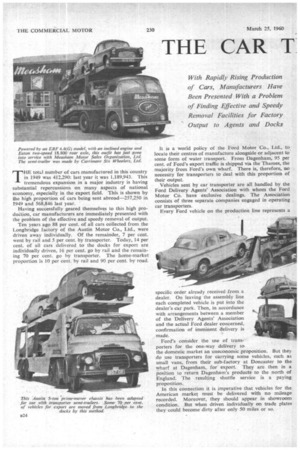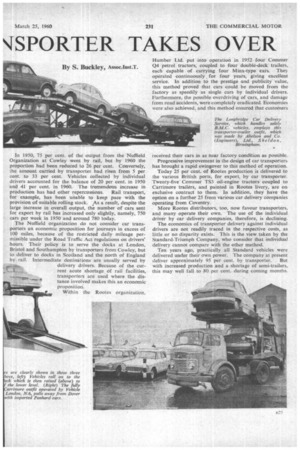THE CAR T \1SPORTER TAKES OVER
Page 58

Page 59

Page 60

If you've noticed an error in this article please click here to report it so we can fix it.
By S. Buckley, Assoc.Inst.T.
With Rapidly Rising Production of Cars, Manufacturers Have Been Presented With a Problem of Finding Effective and Speedy Removal Facilities for Factory Output to Agents and Docks
THE total number of cars manufactured in this country in 1949 was 412,290: last year it was 1,189,943. This tremendous expansion in a major industry is having substantial repercussions on many aspects of national economy, especially in the export field. This is shown by the high proportion of cars being sent abroad-257,250 in 1949 and 568,846 last year.
Having successfully geared themselves to this high production, car manufacturers are immediately presented with the problem of the effective and speedy removal of output. Ten years ago 88 per cent. of all cars collected from the Longbridge factory of the Austin Motor Co., Ltd., were driven away individually. Of the remainder, 7 per cent. went by rail and 5 per cent. by transporter. Today, 14 per cent. of all cars delivered to the docks for export are individually driven, 16 per cent. go by rail and the remaining 70 per cent. go by transporter. The home-market proportion is 10 per cent. by rail and 90 per cent, by road. It is a world policy of the Ford Motor Co., Ltd., to locate their centres of manufacture alongside or adjacent to some form of water transport. From Dagenham, 95 per cent. of Ford's export traffic is shipped via the Thames, the majority from Ford's own wharf. There is, therefore, no necessity for transporters to deal with this proportion of their output.
Vehicles sent by car transporter are all handled by the Ford Delivery Agents' Association with whom the Ford Motor Co. have exclusive dealings. The Association consists of three separate companies engaged in operating car transporters.
Every Ford vehicle on the production line represents a specific order already received from a dealer. On leaving the assembly line each completed vehicle is put into the dealer's car park. Then, in accordance with arrangements between a member of the Delivery Agents' Association and the actual Ford dealer concerned, confirmation of imminent delivery is made.
Ford's consider the use of transporters for the one-way delivery to the domestic market an uneconomic proposition. But they do use transporters for carrying some vehicles, such as small vans, from their sub-factory at Doncaster to the wharf at Dagenham, for export. They are then in a position to return Dagenham's products to the north of England. The resulting shuttle service is a paying proposition. .
In this connection it is imperative that vehicles for the American .market must be delivered with no mileage recorded. Moreover, they should appear in showroom condition. But when driven individually on trade plates they could become dirty after only 50 miles or so. In 1950, 75 per cent, of the output from the Nuffield Organization at Cowley went by rail, but by 1960 the proportion had been reduced to 26 per cent. Conversely, the amount carried by transporter had risen from 5 per cent. to 33 per cent. Vehicles collected by individual drivers accounted for the balance of 20 per cent. in 1950 and 41 per cent. in 1960. The tremendous increase in production has had other repercussions. Rail transport, for example, has been unable to keep pace with the provision of suitable rolling stock. As a result, despite the large increase in overall output, the number of cars sent for export by rail has increased only slightly, namely, 750 cars per week in 1950 and around 780 today.
The Nuffield organization do not consider car transporters an economic proposition for journeys in excess of 100 miles, because of the restricted daily mileage permissible under the Road Traffic Act regulations on drivers' hours. Their policy is to serve the docks at London, Bristol and Southampton by transporters from Cowley, but to deliver to docks in Scotland and the north of England by rail. Intermediate destinations are usually served by delivery drivers. Because of the cur rent acute shortage of rail facilities, transporters are used where the dis tance involved makes this an economic proposition.
Within the Rootes organization,
Humber Ltd. put -into operation in 1952 four Comrner Q4 petrol tractors, coupled to four double-deck trailers, each capable of carrying four Minx-type cars. They operated continuously for fouryears, giving excellent service. In addition to the prestige and publicityvalue, this method proved that cars could be moved from the factory as speedily as single cars by individual drivers. Furthermore, the possible overdriving of cars, and damage from road accidents, were completely eradicated. Economies were also achieved, and this method ensured that customers
received their cars in as near factory condition as possible.
Progressive improvement in the design of car transporters has brought a rapid swingover to this method of operation.
Today 25 per cent. of Rootes production is delivered to the various British ports, for export, by car transporter. Twenty-five Commer TS3 oil-engine tractors coupled to Carrimore trailers, and painted in Rootes livery, are on exclusive contract to them. In addition, they have the option on a further 25 from various car delivery Companies operating from Coventry.
More Rootes distributors, too, now favour transporters, and many operate their own. The use of the individual driver by car delivery companies, therefore, is declining.
The economics of transporter delivery .against individual drivers are not readily traced in the respective costs, as little or no disparity exists. This is the view taken by the Standard-Triumph Company, who consider that individual delivery cannot compare with the other method.
Ten years ago, practically all Standard vehicles were delivered under their own power. The company at present deliver approximately 95 per cent. by transporter. But with increased production and a shortage of semi-trailers, this may well fall to 80 per cent during coming months. Delivery by rail has been tested from time to time. but Standard's have found that the rolling stock is sadly out of date and, in their experience, little is being done to rejuvenate it.
Vauxhall Motors, Ltd., have told me that increasing numbers of agents are operating transporters. The advantage varies according to the length of the journey and the possibility of securing a return load.. Vauxhall would like to see all their products Carried on transporters, although this must be a matter of evolution in view of the comparatively high initial cost of transporter outfits.
However, this year approximately 70 per cent, of the built-up cars leaving Vauxhall's for export will be taken. to the docks by transporter. Seven years ago none was delivered by this method.
Mr. W. E. Herbert, techritcal engineer (sales) of Carrimore Six Wheelers, Ltd., told me the original design of their car transporter trailer was brought out in 1949. At the outset sales were comparatively slow, but in the past few years there has been a substantial increase.
The Carrirnore link motion design gives extra length over the cab, and provides an operation free from jamming. Also, the top deck can be brought down to floor level, which greatly facilitates loading and unloading.
The problem facing the manufacturer of a car trans
porter trailer is that imposed by the Construction and Use Regulations, namely, a maximum overall length for an articulated outfit of 35 ft. together with a maximum width of up to 8 ft., according to the type of tractor employed. The Carrinnore trailer has a loading capacity of either five cars of the Hillman type—three on the top deck and two below—or four cars of larger dimensions.
In designing these trailers Mr. Herbert said he was continually asked by customers, to get the proverbial quart into a pint pot. While Carrimore's did design and manufacture car transporter equipment for both rigid vehicles and drawbar trailers, he considered the articulated outfit by far the best. A typical unladen weight for an articulated car transporter outfit Is 7 tons 15 cwt.-4 tons 12 cvvt. for the trailer and 3 tons 3 cwt. for the tractor.




















































































































